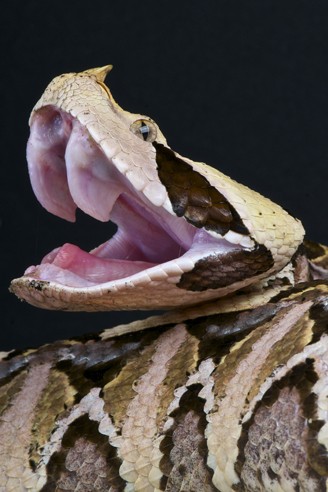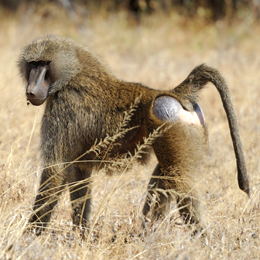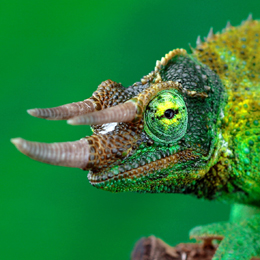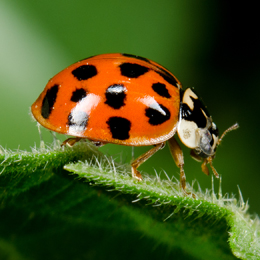Physical Description
Particularly found in the central and western rainforests of Africa, the Gaboon Viper is a docile creature, nevertheless a highly impressive predator that belongs to the family of adders. It is the world’s heaviest viper weighing about 8 – 10 kg (17 – 22 lbs) approximately. On an average, Gaboon vipers have a total length of 125 – 150 cm (4 – 5 ft) where females are generally found to be larger than males. There have been reports of a female Gaboon viper found back in 1973 that weighed around 11,3 kg (24.5 – 25 lbs) with a range length that extended till about 1.8 m (5.9 – 6 ft).
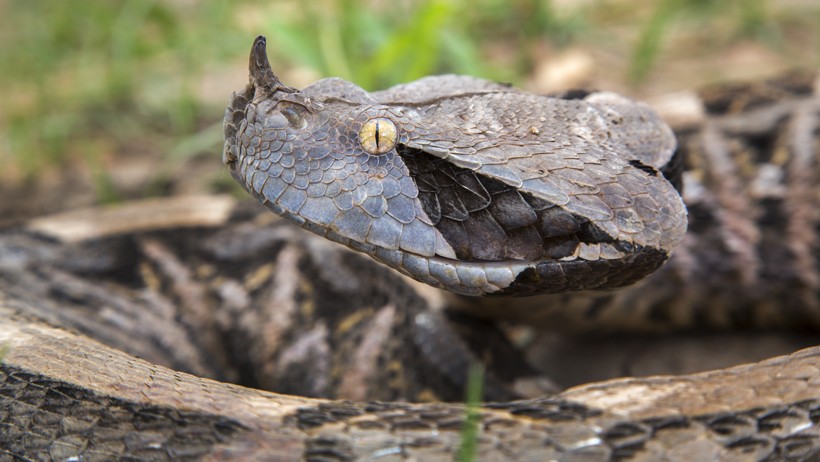
Gaboon vipers are recognizable by its triangular head and paired horns, Ghana (Africa)
?
Image credits: Ivan Kuzmin/Shutterstock
The viper has a large, triangular head, paired horns that are located near the nostrils and a striking pattern spread across its body. The approximate life span of a Gaboon viper in the wild has been recorded to be 18 years. However in captivity, the species can live up to 20 – 22 years at a stretch.
Habitat
The sub-Saharan region in Africa consisting of tropical woodlands is an ideal habitat for many venomous snakes, amongst one is the Gaboon viper. The particular coloring of the snake allows it to easily adapt to its surrounding. The snake’s anatomical features provide excellent camouflage against the dense, dark foliage of the tropical rainforests, allowing this sluggish snake to become invisible against the roots of the forest floor. In the wild, Gaboon vipers tend to find shelter within secondary thickets, low altitude woodlands, cashew plantations and nearby grasslands.
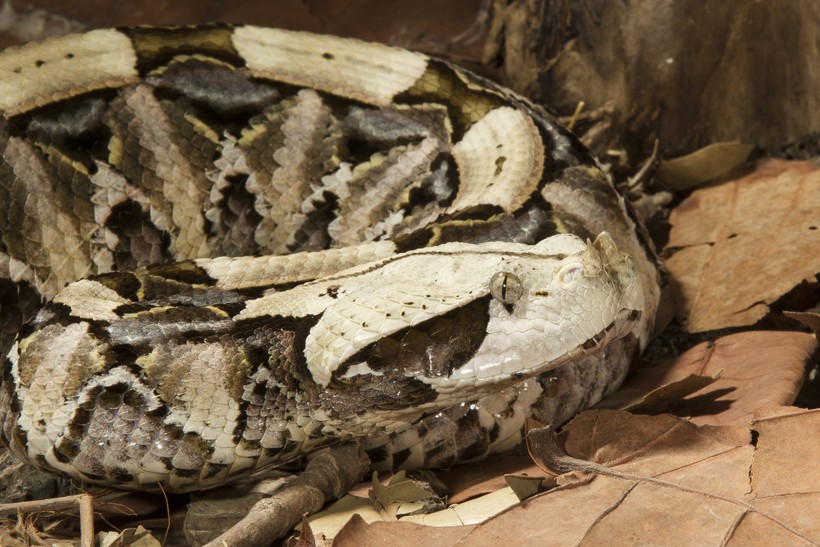
The viper has excellent camouflage on the forest floor
?
Image credits: Dennis W. Donohue/Shutterstock
Some rare sightings in Tanzania have been reported of the snake dwelling in agricultural patches and in the evergreen forests of Zimbabwe. In the western parts of Africa, the viper can often be found in burrows of cacao plantations or coffee estates in the east.
Geographical Distribution
The name ‘Gaboon’ refers to the northern portion of French Congo that was originally one of the first habitats where this species was found dwelling. On a common note, the Gaboon viper can be found in New Guinea, Ghana, Nigeria, Togo, Republic of Congo, Cameroon and northern Angola. The distribution is dispersed across the Central African Republic, Sudan, Zambia, eastern Tanzania, Kenya, Uganda, Malawi and eastern Zimbabwe.
B. gabonica can occur at low densities with an approximate population size of 500 in the South African continent. There have been reports that suggest the presence and continued breeding of this species along the coastal strips of Cape Vidal, Sodwana Bay and Kosi Bay. According to a May 2002 report, a Gaboon viper hatchling that was captured in St. Lucia. This and two rare sightings in the Manguzi town suggest the snake’s ability to survive unnoticed close to human settlement and activity.
It has also been listed as part of national reserves located in Sierra Leone, Liberia and Mozambique. As of today, there are two particular subspecies of the Gaboon Viper
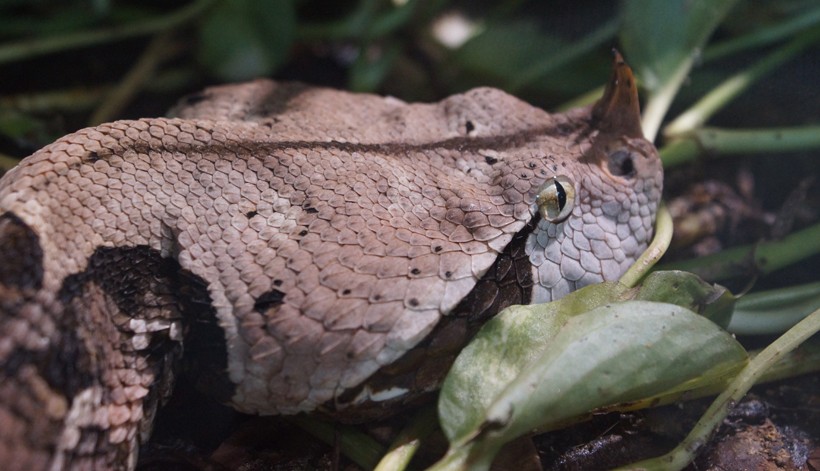
West African Gaboon viper, single black triangular marking under the eye
?
Image credits: poeticpenguin/Shutterstock
- West African Gaboon viper (B. g. rhinoceros)
This species is located particularly in western parts of Africa right from the Ivory Coast to Sierra Leone, including certain parts of Ghana. Though its distribution is limited, this subspecies can also be found in Togo and west of Guinea.
This species is located particularly in western parts of Africa right from the Ivory Coast to Sierra Leone, including certain parts of Ghana. Though its distribution is limited, this subspecies can also be found in Togo and west of Guinea.
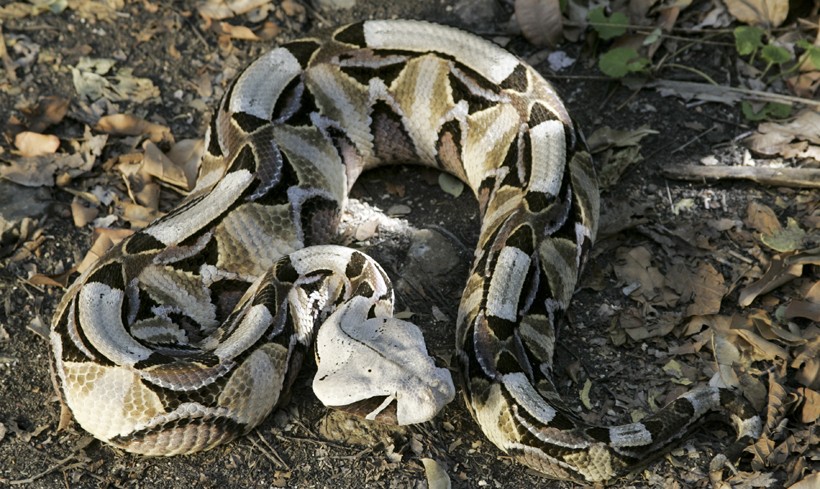
East African Gaboon viper, smaller and a relatively lighter pattern that divides the triangle into two halves under the eye
?
Image credits: Stuart G Porter/Shutterstock
- East African Gaboon viper (B. g. gabonica)
The east African Gaboon viper is another subspecies that is particularly native to the coastal strip of the Gulf of Guinea, Congo basin, great lakes of Zambia, covering the eastern stretch of Central African Republic and extending till the south of Sudan (Central, eastern and southern Africa).
The east African Gaboon viper is another subspecies that is particularly native to the coastal strip of the Gulf of Guinea, Congo basin, great lakes of Zambia, covering the eastern stretch of Central African Republic and extending till the south of Sudan (Central, eastern and southern Africa).
Anatomy
Both subspecies of the Gaboon viper are large showcasing a stout body that is layered with bold patterns in the form of triangles and rectangles of purple and brown. While the western Gaboon viper is larger measuring 5 – 6 ft, its eastern counterpart attains a maximum length of 3 – 4.5 ft. Both the subspecies maintain heart-shaped or triangular shaped heads with a brown line that runs through the center. While the western Gaboon viper showcases a black triangular marking present under each eye, the eastern species has a relatively lighter pattern that divides the triangle into two halves.
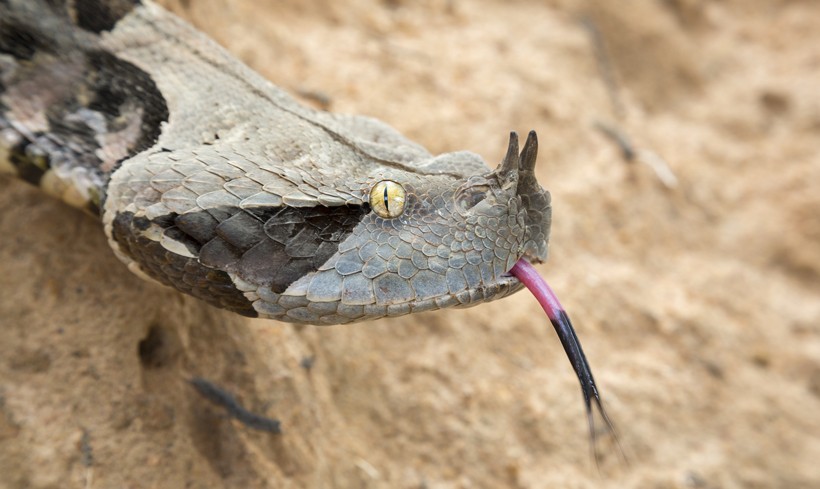
The pair of horns are more prominent by the West African Gaboon viper, (Ghana, Africa)
?
Image credits: Ivan Kuzmin/Shutterstock
A pair of horns is present between its raised nostrils – the western Gaboon viper has a more prominent pair while the eastern species showcases a tinier form. While the mid-body contains 28 – 46 dorsal scales, the ventral scales are around 120 – 140 (predominantly more in males than females). The subcaudal scales (average 17 – 33 pairs) are approximately 25 in males while female Gaboon vipers possess around 23 in total. There is a presence of a single anal scale on this species. The fangs of the Gaboon viper are the largest in size for any venomous snake, measuring about 2.2 inches.
The coloring pattern of the Gaboon viper makes it a lethal predator in the wild. A series of triangular patches run through its center, interspaced with yellow ridges that are dark in color and in the form of hourglass markings. The flanks contain brown colored rhomboidal shapes while the belly possesses a light pale color layered with irregular brown/black blotches. The head can either be cream or pale white with a dark central line that descends towards the mid body. The Gaboon viper’s iris can be silvery-grey, yellow-white or cream colored depending upon its biome.
Diet
The Gaboon viper’s diet primarily consists of small mammals like rabbits, squirrels, field mice etc. It has been found that the viper has a few unlikely preys like a small Royal antelope, Tree monkeys and the Brush-tailed porcupine. Its large size, sharp fangs and camouflaged skin allows it to ambush native birds like doves, francolins and parrots, amphibians like frogs and often tortoise eggs.
Baby Gaboon vipers, unlike adults, feed on smaller prey like insects, frogs, tortoise eggs, field mice and shrews that are easier to catch and swallow.
Prey
One of the most spectacular documentaries to come across is of a Gaboon viper searching for its prey. Like all venomous vipers, the Gaboon can also sense vibrations in the ground that travels till its jawbone and into the skull helping it to determine the presence of a likely prey. The distance of its prey can be easily located by picking up airborne particles that stimulate the Jacobson’s organ. They can also perceive heat radiations with their infrared heat-sensitive senses that are nested around the mouth. Gaboon vipers are nocturnal which means they hunt at night and use a simple technique of ‘ambush’ against their prey.
The darkened skin tone, yellow quadrangular shaped patches on its skin and the hour-glass shaped blotches along its sides give it a stunning appearance. This intricate form of symmetry on its body provides camouflage that help it to blend so well in the surrounding that even humans find it difficult to catch sight of this snake. Once the prey is close enough the viper strikes and injects a large dose of venom using the broadened ends of its fangs.
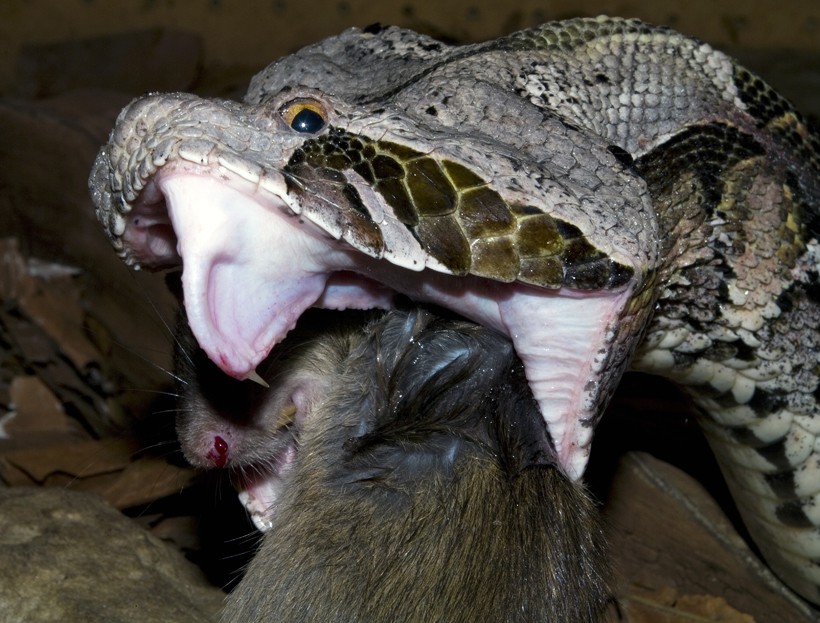
Gaboon viper eating a rodent
?
Image credits: gavinfalck/Shutterstock
They await their prey in the thickets of deep leaf litter and grab ground-dwelling mammals injecting venom that particularly destroys tissues of the prey. Despite the large size of its fangs, the Gaboon viper’s venom doesn’t affect the blood or the nervous system. The venom is cytotoxic causing swelling, severe shock, blisters and convulsions. The Gaboon viper injects around 5 – 7 ml (450 – 600 mg) of venom in a single strike damaging local tissues.
Predator
The Gaboon viper is preyed upon by very few in the wild. However, a known predator that lurks within the African forests is the Monitor lizard. Another predator that commonly hunts puff adders and has fed on Gaboon vipers often is the Secretary bird (Sagittarius serpentarius). Medium sized predators like the King Cobra and Wild Cats also prey on the Gaboon Viper.
Reproductive Cycle
During the mating season, the Gaboon viper is completely ignorant of its surroundings. This is the only period during which there is some form of contact between represents species. During the time of peak sexual activity, the males run into combat over a selected female. This particular scene begins with one male trying to throw down its rival by rubbing their chins against each other. While both raise their heads high, the necks intertwine and a consistent fight for dominance begins. Occasionally the combatants will retire mutually, rest and resume their fight after a certain period. The fight is settled once one of the males pushes down the head of its rival to the ground.
The mating period that starts from September and carries on till December next year primarily occurs in the rainy season. The gestation period can last for about 12 months during which a female Gaboon viper must find a suitable den for her birthing. The Gaboon viper is viviparous and gives birth to about 30 – 50 offspring out of which a minimum lot of 20 can survive. The offsprings, that measure about 30 cm in length, are left to fend for themselves with no parental involvement throughout their maturity.
Behavior
The Gaboon viper is a docile snake, quite sluggish in its movement and generally doesn’t attack, outside foraging, unless it feels threatened. Unlike most venomous snakes in Africa, the Gaboon is quite sedentary that is likely to be active around sunset. Instead of hunting for prey, this species hides within the leaves of the forest floor waiting for a suitable prey to pass over. The Gaboon viper is a very tolerant snake and doesn’t attack humans unless it is accidentally stepped on.
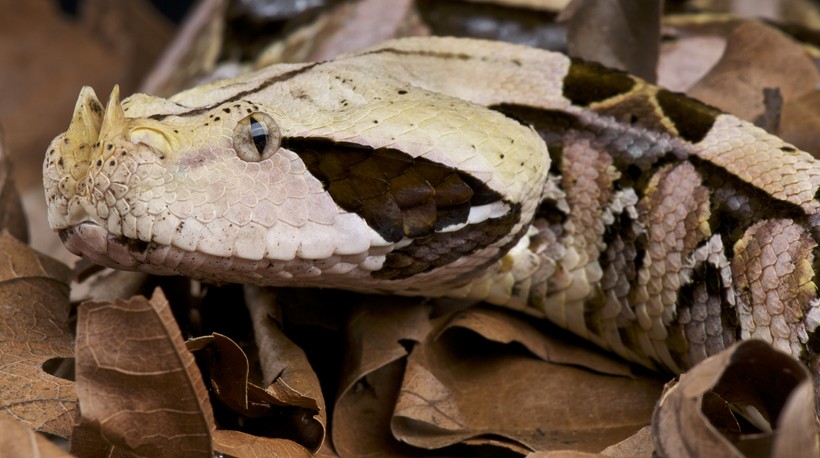
This non-aggressive viper often hides within forest leaves waiting for a prey to pass by
?
Image credits: reptiles4all/Shutterstock
Locomotion of the viper is quite slow. However, there is evidence that shows this species can actually rotate itself. This form of movement is referred to as side-winding that allows the snake to writhe from side to side whenever it feels alarmed. They don’t possess a rattle but hiss in deep, rhythmic patterns by flattening their heads to the ground. Despite being slow in movement, their strike range is one of the highest in the world (175 - 200 miles per hour).
Their non-aggressive nature makes it easier for wildlife researchers to handle them but precautions should be taken since a bad tempered individual can be quite lethal. The snake’s cryptic abilities, solitary behavior and sluggish mobility render it quite harmless. It prefers a moist, cool environment of the tropical rainforests or a closed canopy with the abundance of prey and natural breeding sites to ensure a minimal amount of locomotion.
Threats
Being an apex predator, the Gaboon viper doesn’t face any threat that is directly associated with its well-being. However, several human activities are responsible for habitat destruction of the species causing them to flee into open paddies and coffee plantations. Many parts of southern Nigeria, Niger Delta and the forested grounds of Togo suffer from severe deforestation. This results in degradation of tropical patches, swamps and woodland terrains and thus limiting the natural habitat of the Gaboon viper. Though the species hasn’t been listed on the IUCN Red List, it is facing population decline in the western parts of Africa.
Human activity in the Niger Delta traditionally includes land clearance, planting, post harvesting storage. Generally taking place during the dry months from December to April, such form of land clearance destroys many breeding burrows of the West African Gaboon viper. This has reduced the reproduction of the Gaboon viper species. Palm oil production, a common economic practice in the Niger Delta is one of the main causes for illegal logging. Trampling has also become a common tragedy that leads to fatal bites as many humans are unable to detect the Gaboon viper’s well-concealed presence and happen to step on it accidently.
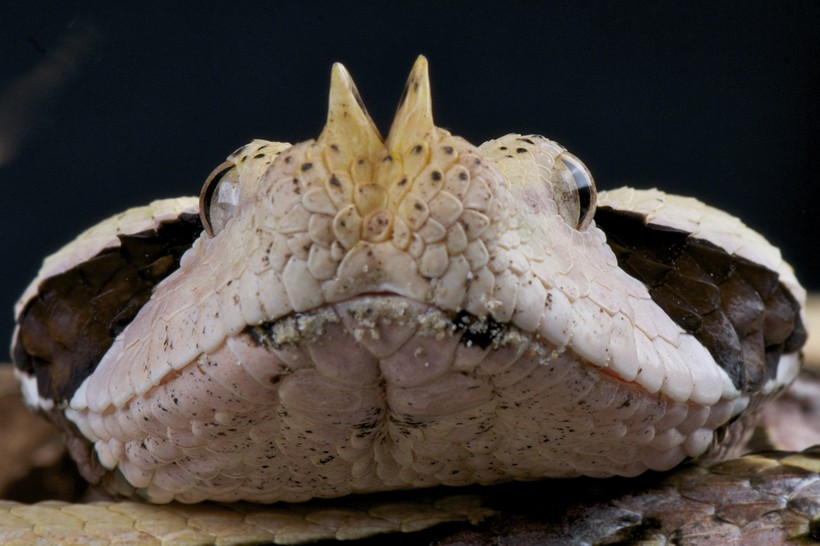
The gaboon viper is one of the many species that suffer from severe deforestation
?
Image credits: reptiles4all/Shutterstock
Since it is cryptically colored, the snake can rarely be seen as it buries itself in leaf litter or sand. Surprisingly the species can also be found in the Kosi Bay area, with a few rare sightings that occur only three hundred meters away from human settlements. Road kills, taking place particularly near St. Lucia or along the coastal strip is another growing concern for many conservationists. Part of the Manguzi Forest, that is a well-renowned habitat of the Gaboon viper, has been converted into an agricultural layout.
Conservation Status
The Gaboon viper that can be found in the moist Guinea savannahs of Africa prefers a humid environment that has commonly been sighted on agro-industrial plantations and forest edges. Despite the fact that the species occupies a population density of 0.053 animals per hectare, currently there is no data available that show a decline of this species. Locally abundant, around 282 individuals had been identified in Cote d'Ivoire (2008), 2% of which are being protected at the Tai National Park.
According to the IUCN, this species is considered a least concern but the Western Gaboon viper has become a ‘Threatened’ species in parts of Nigeria. Intensive research has been carried out on the Gaboon adder and its conservation in dominant regions of Africa like the northern KwaZulu/Natal. In the South African Red Data Book, the Gaboon viper is a ‘vulnerable’ species and in the tropical coastal forests of KwaZulu/Natal, the species is listed as ‘Endangered’.
Funfacts
- The Gaboon viper is the heaviest viper that possesses the longest fangs up to 2.2 inches (5 cm) in length.
- The Gaboon viper is also known as the West African behemoth.
- This species spends three-quarters of its time in ambush, sitting quietly within the leaf litter.
- A male Gaboon viper can travel two-thirds of a mile in a single day while hunting for a suitable mate.
- Gaboon vipers give birth once every two to three years.
- The Gaboon viper has evolved the ability to retain its feces for an incredibly long period (months to years)
- In a 1995 conservation project, many Gaboon viper species were translocated from the Dukuduku Forest (that suffered from severe deforestation) to the Umlalazi National Reserve.
- Dune mining in Africa (e.g. Dukuduku Forest) is a major cause for habitat loss of the Gaboon viper.
- The gaboon viper has a strike range of 175 - 200 miles per hour
